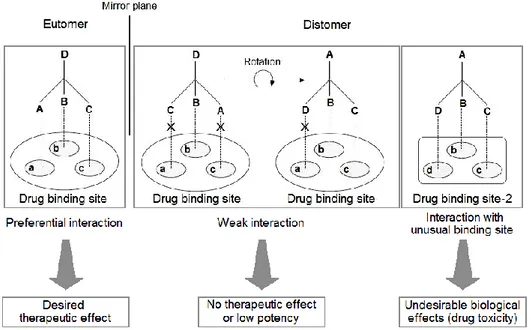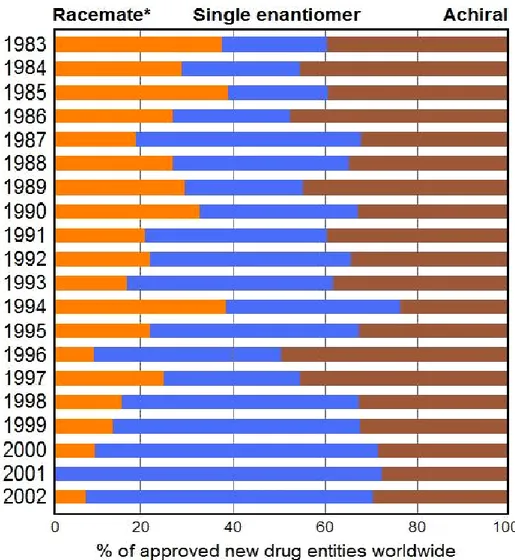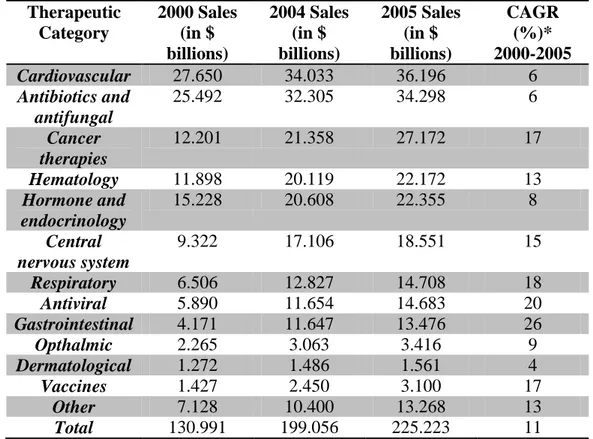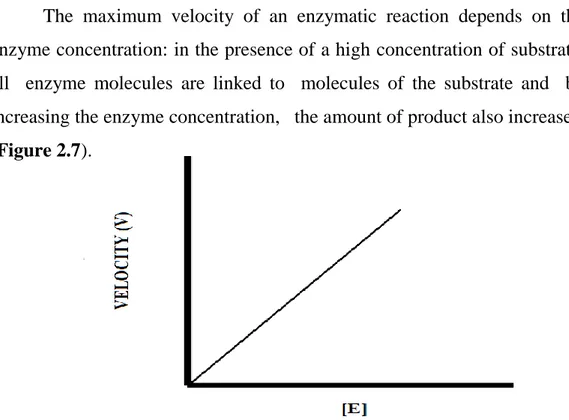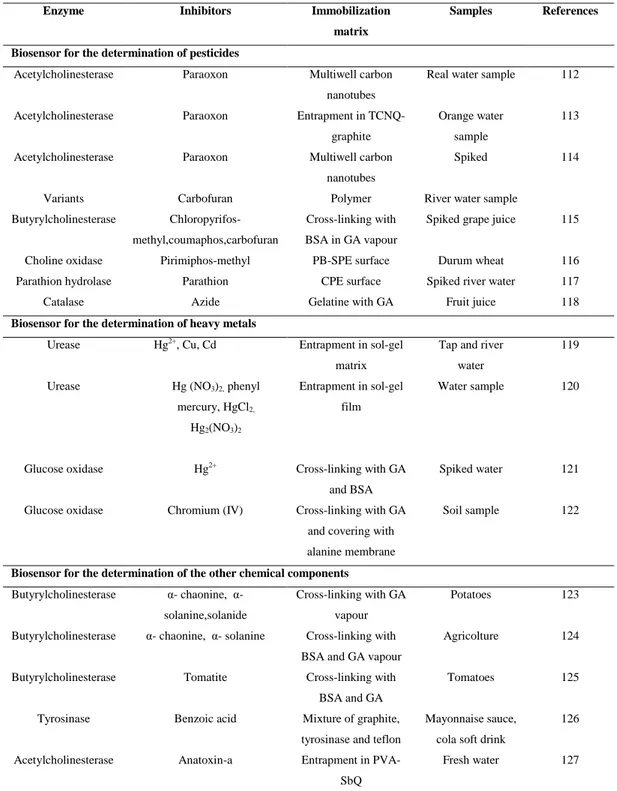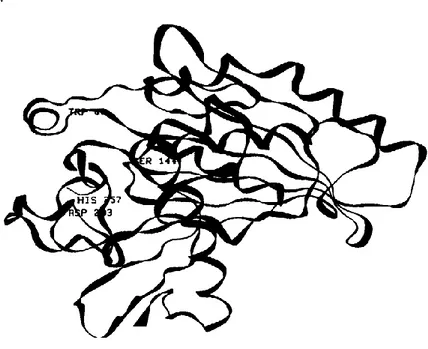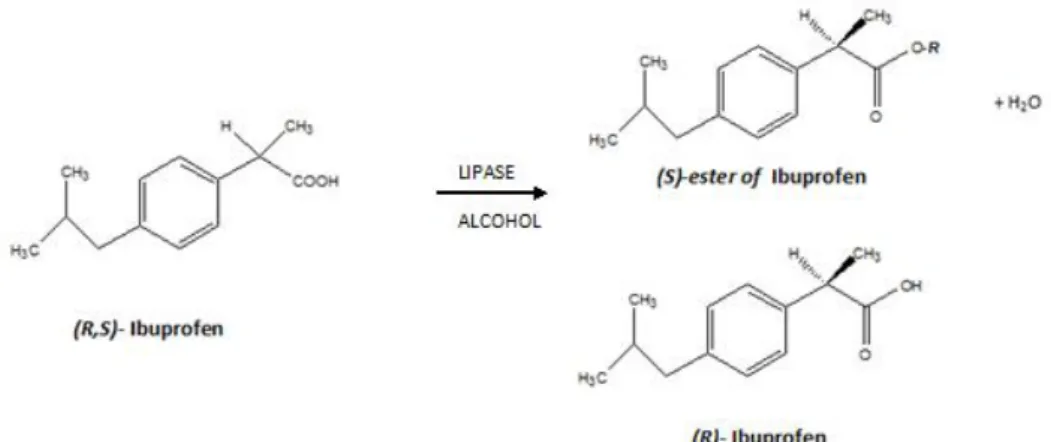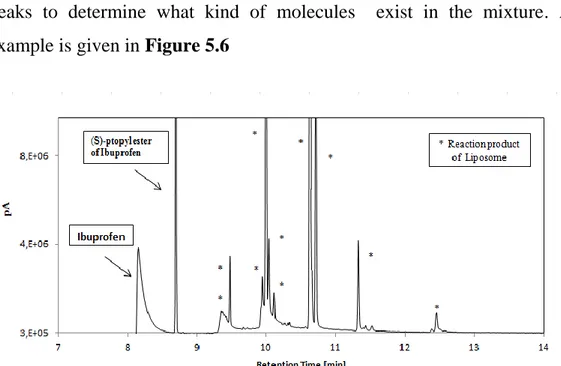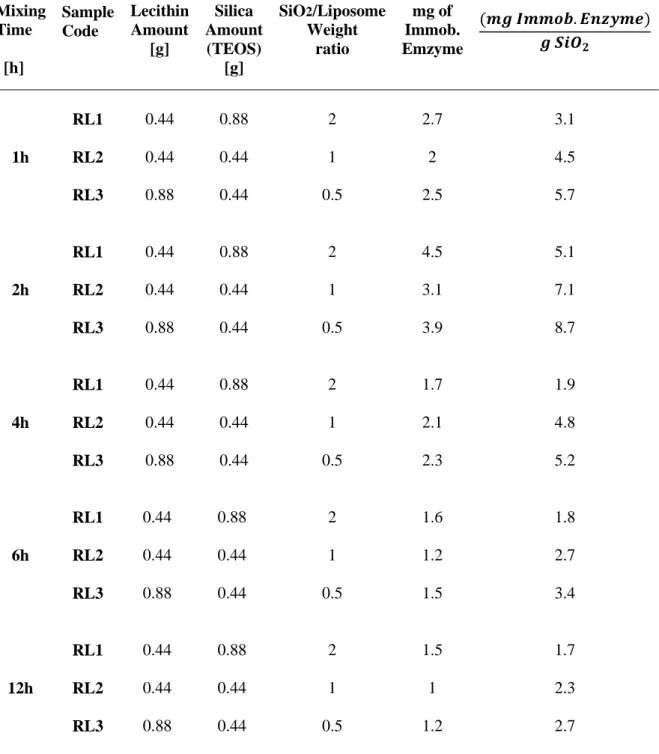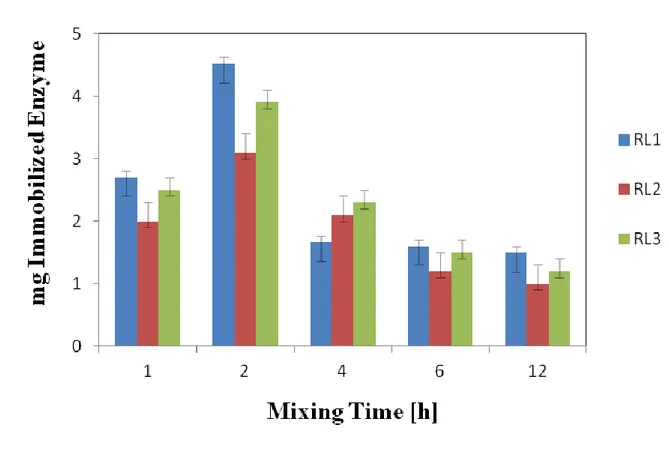PAG.
ABSTRACT
SOMMARIO
INTRODUCTION
1 4 7
CHAPTER I
: OVERWIEV OF CHIRALITY
1.1 Introduction of chirality
111.2 Chiral drug in biological system
131.3 Tendence and development of chiral drugs
161.4 Methods of enantioselective synthesis
Reference
19 28
CHAPTER II:
ENZYMES
2.1 Introduction to enzyme
302.2 Enzyme catalysts
312.2.1 Enzyme structure
312.2.2 Enzyme flexibility
342.2.3 Mechanism of enzymatic catalysis
352.2.4 Performance of enzyme activity
2.3 Overview of enzyme classes (EC numbers) and related
reaction.
40 44
2.4 Microbial lipase
482.5 Industrial application involving microbial lipase
492.6 Lipase from Rhizomucor miehei
642.7 Rhizomucor miehei lipase as catalyst in the resolution of
chiral compound
69References
73CHAPTER III:
IMMOBILIZED LIPASE
3.1 Historical Background
843.2 Advantage of immobilized enzyme
853.3 Choice of support
863.4 Methods of enzyme immobilization
3.4.1 Methods of irreversible enzyme immobilization
88 88
3.4.1.1 Covalent enzyme immobilization
893.4.1.2 Enzyme entrapment and encapsulation
913.4.1.3 Cross-link immobilization
933.4.2 Methods of reversible immobilization
943.4.2.1 Adsorption on/in organic supports
953.4.2.2 Adsorption on mesoporous silica and zeolites
973.4.2.3 Protein-coated microcrystals
References
100 101
CHAPTER IV:
INTRODUCTION OF THE EXPERIMENTAL
WORK OF THE THESIS
4.1 Aim of the thesis work
1094.4.1 Ibuprofen: general Information
112References
114CHAPTER V:
MATERIALS AND METHODS
5.1 Materials
1165.2 Details on used enzyme: Rhizomucor miehei Lipase
1175.3 Methods of lipase immobilization: general procedure
1185.4 Esterification reaction of (R,S)-Ibuprofen using
immobilized lipase
1215.5 Protein estimation
5.6 Catalyst characterization
5.6.1 Thermogravimetric analysis
5.6.2 Fluorescence confocal microscopy
5.6.3 N
2Adsorption/Desorption
5.6.4 Transmission electron microscopy (TEM)
5.6.5 Nuclear magnetic resonance spectroscopy (NMR)
5.6.6 Powered X-Ray Diffraction (XRD)
5.7 Product reaction determination
5.7.1 Gas chromatography analysis
5.7.2 Chiral gas chromatography analysis
References
123 124 124 125 127 130 133 134 137 137 144 147CHAPTER VI:
RESUTS AND DISCUSSIONS
6.1 Catalytic characterization results
1486.1.1
Detailed characterization results of selected catalyst
1486.2 Catalytic test results
6.2.1 Influence of the catalyst composition
164 167
6.2.2 Influence of the alcohol
1716.2.3 Influence of the temperature
1756.2.4 Influence of the solvent nature
1766.2.5 Comparison with free lipase
1776.2.6 Stability and productivity of catalysts
182References
CONCLUSION
Appendix
191 192 201ABSTRACT
Lipase are able to catalyze esterification reactions in organic solvents displaying higher enantioselectivity than that showed in hydrolytic reactions. Among the high number of lipases described in the literature, only the enzymes belonging to a few species have been demonstrated to have adequate stability and biosynthetic capabilities to allow routine use in organic reactions and, hence, their applications as industrially relevant enzyme. Because of these properties, Lipases have been widely used for the production of enantiomerically pure compounds, resolving racemic alcohols and organic acids. There is an increasing trend toward the use of optically pure enantiomers for drugs because they are more specific targets and have fewer side-effects than racemic mixtures. Among 1800 drugs currently available, about half are chiral mixture. Racemic drugs have usually the desired therapeutic activity mainly in only one of the enantiomers.In this sense, 2-aryl propionic acids (profens), that make up an important group of non-steroidal anti-inflammatory drugs (NSAIDs) used in the treatment of arthritis and related diseases shows mainly the pharmacological activity by their corresponding (S)-enantiomer, 100-fold more active than its antipode. Therefore, since pharmacological studies have indicated that gastrointestinal problems are the most frequent side effects associated with profens consumption,important efforts to synthesize pure enantiomers of 2-aryl-propionic acids are currently in progress. Ibuprofen, 2-(4-isobutyilphenyl) propionic acid, is a racemic carboxylic acid, showing each enantiomer a physiologically different behavior, being the (S)-enantiomer the form that exhibits an anti-inflammatory property. In recent years, lipase have been used for the chiral resolution of (R,S)-ibuprofen through mainly direct enantioselective esterification in organic media of its chemically synthesized racemic ester. Among different lipases,
immobilized Rhizomucor miehei lipases is able to catalyze the esterification reaction.
Particularly, in this work, the Lipase from Rhizomucor Miehei has been immobilized into hybrid nanospheres containing a liposomal core, where enzyme is confined. The organic phase (Liposome + Lipase) has been protected by inorganic silica matrix obtained with and without surfactant. The influence of several experimental factors in the synthesis of immobilized lipase from Rhizomucor miehei in liposomal phase, such as silica/liposome weight ratio and mixing time between liposome and lipase, have been studied. All samples have been characterized, by base and advanced analytic techniques, in order to check the best procedure to obtain perfect hybrid nanosphere where lipase is perfectly in the core of the liposome phase. The optimized procedure has been used to prepare hybrid nanosphere with different silica shell. In particular, the silica cover has been prepared with or without surfactant. When surfactant has been used, hexadecylamine was the organic.
The optimized heterogeneous catalysts have been used in the enantioselective esterification of racemic ibuprofen to evaluate their catalytic performance. Particularly, the influence of several catalytic parameters on the activity of hybrid nanospheres, such as type of the solvent (a-polar solvent:isoctane; polar solvent: dimethylformamide), type of the alcohol (primary alcohol with different chains length: methanol; 1-propanol; 1-butanol) and reaction temperature (27, 37, 50 and 80 °C), has been investigated. The best catalytic performance of heterogeneous biocatalyst have been showed at 37°C, using iso-octane as solvent and 1-propanol as alcohol (ester yield value ranging between 78 and 93%). A strong iper-activation of immobilized enzyme, with respect to the free form, has been observed: in the same reaction conditions the ester yield of free Lipase is only the 25%. The reusability (turnover number (TON) and turnover number of frequency (TOF)) and the stability of heterogeneous
biocatalysts were also determined for a potential industrial application. The stability of the prepared biocatalyst is very high: up to 9 reaction cycles with a TOF number 16-fold higher than that of free lipase.
SOMMARIO
Le Lipasi sono adatte a catalizzare reazioni di esterificazioni in solventi organici, mostrando elevata enantioselettività rispetto a quella mostrata nelle reazioni di idrolisi. Rispetto al grande quantitativo di Lipasi descritte in letteratura, solo gli enzimi derivanti da poche specie hanno dimostrato di avere una adeguata stabilità e capacità di biosintesi che hanno permesso di utilizzarle in reazioni organiche e, quindi, la loro applicazione come enzimi di interesse industriale. Grazie a tali proprietà, le Lipasi sono stati ampiamente utilizzate per la produzione di composti enantiomericamente puri, nella risoluzione di alcool racemici e acidi organici. Vi è una tendenza sempre più in crescita verso l'uso di farmaci in forma di enantiomeri otticamente puri perché hanno target più specifici e hanno meno effetti collaterali rispetto alle miscele racemiche. Tra 1800 farmaci attualmente disponibili, circa la metà sono miscele chirali. Solitamente l'attività terapeutica di un farmaco viene mostrata solo da uni solo degli enantiomeri. In questo senso, l'attività farmacologica dei profeni, che costituiscono un importante gruppo di farmaci anti-infiammatori non steroidei (FANS) utilizzati nel trattamento di artrite e di malattie correlate, viene mostrata dal rispettivo (S) -enantiomero, che mostra un'attività 100 volte maggiore rispetto al suo antipode. Pertanto sforzi importanti per sintetizzare enantiomeri puri dei profeni sono attualmente in corso. Ibuprofene, è un acido carbossilico racemico, di cui ciascun enantiomero mostra un comportamento fisiologicamente diverso, essendo l'enantiomero (S) la forma che presenta una proprietà anti-infiammatoria. Negli ultimi anni, le lipasi sono stati utilizzati per la risoluzione chirale di (R,S)-Ibuprofene tramite esterificazione enantioselettiva, principalmente diretta in mezzi organici, per l'ottenimento del rispettivo estere racemico.
Tra le diverse lipasi, la Lipasi da Rhizomucor miehei è in grado di catalizzare reazioni di est In particolare, in questo lavoro, la lipasi da
Rhizomucor miehei è stato immobilizzato in nanosfere ibridi contenenti un nucleo liposomiale, in cui l'enzima è confinato. La fase organica (liposomi + lipasi) è stata protetta da una matrice di silice inorganica, creando cosi una struttura nanoparticellare (biocatalizzatori eterogenei).
L'influenza di importanti fattori sperimentali nella procedura di sintesi dei biocatalizzatori ibridi sono stati studiati: il rapporto in peso tra la quantità di silice e di liposoma utilizzate, e il tempo di miscelazione tra liposoma e lipasi. Tutti i campioni sono stati caratterizzati mediante note ed avanzate tecniche analitiche, al fine di mettere a punto una procedura si sintesi ottimale per l'ottenimento di un biocatalizzatore eterogeneo morfologicamente omogeneo in cui lipasi è perfettamente immobilizzata all'interno della fase liposomiale, a sua volta perfettamente ricoperta dal guscio di silice inorganica. La procedura ottimizzata è stata utilizzata per la preparazione di due tipologie di nanosfere ibride, in cui il guscio di siliceinorganica è stato sintetizzato con e senza l'utilizzo del surfattante (Hexadecylamine). I catalizzatori eterogenei ottimizzati sono stati successivamente utilizzati come catalizzatori, nel processo di esterificazione enantioselettiva dell' Ibuprofene racemico, allo scopo di valutarne la prestazione catalitica. In particolare, è stata studiata l'influenza di diversi parametri sulla performance catalitica dei biocatalizzatori eterogenei ottimizzati:
natura del solvente (un solvente polare: isoottano; solvente polare: dimetilformammide);
tipologia di alcool (alcool primario con differente lunghezza della catena : metanolo; 1 -propanol; 1-butanolo);
temperatura di reazione (27, 37, 50 e 80 ° C).
La migliore prestazione catalitica per il biocatalizzatore eterogeneo, è stato mostrato a 37 ° C, utilizzando isoottano come solvente e 1-propanolo come alcool (valore di rendimento estere compreso tra 78 e
93%). Inoltre, è stata osservata una forte iper-attivazione dell'enzima immobilizzato, rispetto alla forma libera: nelle stesse condizioni di reazione la resa in estere della Lipasi Libers risulta essere solo del 25%.
Inoltre, il riutilizzo (numero di turnover (TON) e numero di turnover di frequenza (TOF)) e la stabilità dei biocatalizzatori eterogenei sono stati determinati per una potenziale applicazione industriale. La stabilità dei biocatalizzatori ottimizzati sintetizzati è molto elevata: fino a 9 cicli di reazione con un numero TOF 16 volte più alto di quella della lipasi libera.
Drug chirality is now a major theme in the design, discovery, development, launching and marketing of new drugs. Stereochemistry is an essential dimension in pharmacology. In past decades, the pharmacopoeia was dominated by racemates and due to the emergence of new technologies in the 1980s that allowed the preparation of pure enantiomers in significant quantities, the awareness and interest in the stereochemistry of drug action has increased.
Chiral molecules are constituents of a large proportion of therapeutic agents. The separation of enantiomers is of great interest to the pharmaceutical industry since more than half of pharmaceutically active ingredients are chiral. Chiral chemistry was discovered by Louis Pasteur (a French chemist and biologist) when he separated by hand, for the first time in 1848, the two isomers of sodium ammonium tartrate.
Chiral compounds exist in two enantiomeric forms, which have identical molecular formula but whose structural arrangement form no-superimposable mirror images. However, it needed to wait about a century to find that the phenomenon of chirality plays a key role not only in the life of plants and animals but also in pharmaceutical, agricultural and other chemical industries. Most biomolecules, such as enzymes, proteins, hormones, nutrients, sugars, fats, and many others are chiral. Many drugs, such as food additives, flavors and fragrances or agrochemicals are chiral and often the properties of the two enantiomers are very different. When one enantiomer is responsible for the activity of interest, its paired enantiomer could be inactive, be an antagonist of the active enantiomer or have a separate activity that could be desirable or undesirable. For example, the enantiomers of chiral drugs such as omeprazole and ibuprofen, exhibit different pharmacological and pharmacokinetic activities because they interact with enzymes and receptors consisting of amino acids and other chiral biomolecules. In many cases, one enantiomer is the active pharmaceutical ingredient while the other can be benign or even toxic.
In pharmaceutical industries, 56% of the drugs currently in use are chiral products and 88% of the last ones are marketed as racemates consisting of an equimolar mixture of two enantiomers. Nowadays, there is an increasing effort in industrial research to develop new methods for chiral drug production. The current developed methods are:
Chiral pool synthesis
Laboratory-invented chiral building blocks (“new chiral pool”) Asymmetric synthesis
Resolution of racemates Biotransformations.
Each of them posses different advantages and disadvantages. Particularly, the Biotransformation method employs biocatalyst for organic synthesis of racemates. This method presents many noble features in the field of Green Chemistry and the synthesis of enantiopure drugs. The application of enzymes in organic synthesis provides advantages in comparison with conventional chemical methods, such as a mild reaction condition, high regio-, chemo- and enantio-selectivity, high catalytic efficiency and high product purity and quality. The main disadvantage in the enzyme use is the high cost of biocatalyst that can be overcame by confining it in a specific space of reactor. By immobilization procedure, the enzyme can be used for more than one reaction cycle, strongly reducing the cost related to its use. Sometimes, the immobilization could also activate the catalytic center of the enzyme, especially for Lipases species.
The work of the thesis has been developed in this scenario. Particularly, the Lipase from Rhizomucor Miehei has been immobilized into hybrid nanospheres containing a liposomal core, where enzyme is confined. The organic phase (Liposome+Lipase) has been protected by inorganic silica matrix obtained with and without surfactant.
Liposomes have been chosen as organic protection of lipase because they represent a very suitable micro-environmental of enzymes, that can preserve the enzyme structure and life.
Liposomes are small vesicles with a diameter of 50-500 nanometers. Their structure is characterized by the presence of one or more external phospholipid bilayers, delimiting the inside of a heart in which the hydrophilic material is located in the aqueous phase (Figure 1).
Figure 1.Structure of liposome
The optimized heterogeneous biocatalyst has been used for enantioselective esterification of (R,S)-ibuprofen. Ibuprofen is a racemic carboxylic acid showing in each enantiomer a physiologically different behavior, being the (S)-enantiomer the form that exhibits an anti-inflammatory property.
In details, the thesis work has been structured in 6 Chapters.
In the CHAPTER I has been given an overview on the topic of chirality, the tendency and development of chiral drugs and an outline of the methods of enantioselective synthesis.
CHAPTER II has been focused on enzymes (general aspects, structures and classification) and the basic principles of enzyme catalysis. Subsequently, much attention has been paid on the enzyme Lipase, its industrial applications and, especially on the Lipase used in the present work, as catalyst in the resolution of chiral compound: Lipase from Rhizomucor miehei (RML).
The advantages of the use of immobilized enzyme in catalysis has been discussed in CHAPTER III.
After a brief introduction of the experimental work of the thesis, reported in the CHAPTER IV,the experimental details relating to materials, methods and equipment used for the construction of the experimental work, have been described in CHAPTER V.
Finally, CHAPTER VI has been dedicated exclusively to the discussion of the obtained experimental data.
CHAPTER I
Overview of Chirality
1.1 INTRODUCTION OF CHIRALITY
The word "Chiral" is derived from the Greek word "cheir", which means "handedness", and is a fundamental property of a three-dimensional object. The concept was introduced for the first time by Sir L. Thompson, Lord Kelvin (1824-1907) who said: «I call any geometrical figure, or group of points, chiral, and say that it has chirality, if its image in a plane mirror, ideally realized, cannot be brought to coincide with itself».
Chirality is often illustrated with the idea of left- and right-handedness (Figure 1.1): a left hand and right hand are mirror images of each other but are not overlapping. The two mirror images of a chiral molecule are termed enantiomers. Like hands, enantiomers come in pairs. Both molecules of an enantiomer pair have the same chemical composition and can be drawn the same way in two dimensions, but in chiral environments such as the receptors and enzymes in the body, they can behave differently.
Figure 1.1Mirror images (enantiomers) of Alanine molecule.
The origin of the chirality resides in stereoisomerism. Stereoisomers are compounds that have the same molecular formula and the same functional groups bonded together, but which differ in the three-dimensional arrangement of their atoms or groups. The condition for the creation of a stereoisomer is the presence of at least one asymmetric carbon atom in the molecule. A chirality occurs whenever a carbon atom has four different atoms or groups attached to it. It is also said to be chiral and such as asymmetric atom is called chiral center. Carbon is not the only atom that can act as an asymmetric center. In fact, sulfur, phosphorus and nitrogen can sometimes form chiral molecules such as omeprazole, cyclophosphamide and methaqualone, respectively1. A chiral molecule is not super-imposable with its mirror image and hence there is a possibility of two mirror image forms, called enantiomers. Such space isomers are known as enantiomers. The enantiomers of a chiral compound exhibit similar physicochemical properties in an achiral environment, but they rotate the plane of polarized light in opposite directions and react at different rates with a chiral compound. Isomers that are not enantiomers are called diastereomers. These have the same structural formula, but are not mirror images of one another, and generally exhibit different physical properties, even in a achiral environment. An equimolar mixture of the two enantiomers of a chiral compound is called a racemic mixture that does not exhibit optical activity.
The designation of different stereoisomers is somewhat complicated since there are at least three different systems to classify them and all are used more or less accidentally. The first system of stereoisomer nomenclature is the (d/l) or (+/-) system that is based on the direction in which the compound rotates plane-polarized light. Enantiomers that rotate plane-polarized light to the right are termed dextrarotatory which is indicated by d- or (+)- before the name of the compound, and those that rotate light to the left are termed levorotatory and are designated by a l- or
(-)- prefix. Racemic mixture is denoted with sign (+/-) or (d/l) or with prefix rac 2. This system has been used in chemistry for a long time, but the rotation of plane-polarized light is not an absolute property of a compound but is affected by many factors, such as the solvent used.3 The current system of denotation of stereoisomers is based on the sequence of atoms or groups around its chiral centre and has a conventional character. It is known as the Cahn-Ingold-Prelog (CIP) system or (R,S)-system4. The configuration is indicated by use of prefixes R(Latin: Rectus means right) and S(Latin: Sinister means left) CIP system criteria: a higher atomic number or a higher atomic mass is given higher priority; when the proximate atom of two or more of the substituents are the same, the atomic number of the next atom determines the priority; double bonds or triple bonds are counted as if they were split into two or three single bonds, respectively; cis is given higher priority than trans; long pair electrons are regulated as an atom with atomic number 0; and proximal groups have higher priority than distal groups. If counting from the highest priority (highest atomic number or highest mass) to the lowest one, goes in a clockwise direction, the configuration is designated as R; otherwise if counting goes in a counter clockwise direction, the configuration is designated as S. A racemate is designated as RS. Depending upon the direction of plane polarized light towards right (+) or left (-),each R- and S-enatiomer is designated as R (+) or R(-) and S(+) or S(-)2 .
1.2 CHIRAL DRUGS IN A BIOLOGICAL SYSTEM
The enantiomers of a chiral drug display different types of biological behavior in a chiral living system. These variations may lead to differences in biological activities. Indeed, biological systems can recognize the two enantiomers as two different substances, and their interaction with each
other will therefore elicit different responses. The R-enantiomer of a drug will not necessarily behave the same way as the S-enantiomer of the same drug, when taken by a patient. To explain this we consider a hypothetical interaction between a chiral drug and its chiral binding site (Figure 1.2). The portions of the drug labeled A, B, and C must interact with the corresponding regions of the binding site labeled a, b, and c for the drug to have its pharmacological effect. The active enantiomer of the drug has a 3-dimensional structure that may bind precisely to the target sites (a, b, c), while the inactive enantiomer cannot bind in the same way no matter how it is rotated in space. Although the inactive enantiomer possesses all of the same groups A, B, C, and D as the active enantiomer, they cannot all be simultaneously aligned with the corresponding regions of the binding site.
Figure 1.2. The Hypothetical Interaction Between the two Enantiomers of a Chiral Drug and Its Binding Site
Thus, the difference in their 3-dimensional structures allows the eutomer to exert a desired pharmacological effect while preventing the distomer from exerting the same desirable pharmacological effect1.In some cases, the portion of a molecule containing the chiral center(s) may be in a
region that does not play a role in the molecule’s ability to interact with its target. In these instances, the individual enantiomers may display very similar or even equivalent pharmacological behavior at their target site. Even in these cases, the enantiomers may differ in their metabolic profiles as well as their affinities with other receptors, transporters, or enzymes. Therefore, for a given chiral drug, it is appropriate to consider the two enantiomers as two separate drugs with different properties unless otherwise proven experimentally. The examples of differential enantiomer potency of chiral drugs are reported.
1. Racemic drugs with one major bioactive enantiomer. In this
group, there are a number of cardiovascular drugs, agents widely used for the treatment of hypertension, heart failure, arrhythmias, and other diseases. Among these are the β-adrenergic blocking agents, calcium channel antagonists and angiotensin-converting enzyme (ACE) inhibitors. Levorotary–isomer of all blockers is more potent in blocking β-adrenoceptors than their dextrorotary-isomer, in the same way as S(-)-propranolol is 100 times more active than its R(+)-antipode 5-6. However, it has been demonstrated that d,l- and d-propranolol can inhibit the conversion of thyroxin (T4) to triiodothyronin (T3), contrary to its l-form 7-8. Therefore, single d-propranolol might be used as a specific drug without β-blocking effects to reduce plasma concentrations of T3 particularly in patients suffering from hyperthyroidism in which racemic propranolol cannot be administered because of counter effects for β-blocking drugs5. In neurology and psychiatry, many of the drugs used are chiral compounds and most of them are marketed as racemates. Hypnotics such as hexobarbital, secobarbital, are racemic compounds and for all of these, only l-isomer is hypnotic or sedative, the other is either inactive or excitative. For example, S(-)-secobarbital is more potent as an anesthetic than R(+)-secobarbital i.e. it causes a smoother more rapid anesthetic effect 9.
2. Both enantiomers having equal therapeutic properties. There
are only some racemic drugs that could belong to this group such as cyclophosphamide (antineoplastic), flecainide (antiarrhythmic), fluoxetine (antidepressant)10.
3. Racemic drugs with chiral inversion. Directional inversion was
described with 2-arylpropionate nonsteroidal anti-inflammatory drugs (NSAID), such as ibuprofen, ketoprofen, etc. For this group, only S-enantiomer is active and has an analgesic and anti-inflammatory effect. For example, S-ibuprofen is over 100-fold more potent as an inhibitor of (R)-ibuprofen.
1.3 TENDENCE AND DEVELOPMENT OF CHIRAL
DRUGS
The authorities in many countries began to issue regulatory guidelines on chiral drugs in the mid-1980s owing to the accessibility of enantiomerically pure drug candidates and the accumulation of knowledge on chiral drugs.
The first policy statement regarding the development of new stereoisomeric drugs was published by The United States Food and Drug Administration in 1992 11. In 1994, guidelines concerning investigations into any chiral active substance were issued by a commission of European countries. With the stiffening of regulations, demand for chiral raw materials, intermediates, and active ingredients has grown dramatically since 199012. An overall look at the 20-year period from 1983–2002 (Figure 1.3), shows that the single enantiomers drug segment has become an important part of the overall pharmaceutical market (39% of worldwide
approved drugs). Single enantiomers reached 50% of all approved drugs for the first time in 1998, rising to >60% between 2000–2001, probably due to the directives of the major regulatory agencies which favored and encouraged the development of single-enantiomer drugs over racemates13.
*Data includes the diastereomeric mixture.
Figure 1.3. Emergence of single enantiomeric drugs: A worldwide scenario for 20 years; single
enantiomers have dominated racemates since 199014
According to estimates from Technology Catalyst International and IMS Health (Table 1.1), single enantiomers therapeutics had sales of $225 billion in 2005, representing 37% of the total formulation pharmaceutical market of $602 billion.
Besides the development of new drugs in single enantiomeric form, chiral technology has a crucial role in the re-evaluation and remarketing of single enantiomeric forms of existing racemic drugs ("Racemic switching": a reprocessing and reformulation of a racemic mixture, into its single enantiomer product) which permits additional years of market exclusivity . Besides drugs, ‘chirality’ is receiving attention from several business sectors such as biochemicals, agrochemicals, aroma and flavour compounds, dyes and pigments and polymers. The industrial demand for enantiopure chemicals is therefore expected to show explosive growth in the coming years15.
Table 1.1. Wordwide sales of single-enantiomer pharmaceutical products final formulation16
Therapeutic Category 2000 Sales (in $ billions) 2004 Sales (in $ billions) 2005 Sales (in $ billions) CAGR (%)* 2000-2005 Cardiovascular 27.650 34.033 36.196 6 Antibiotics and antifungal 25.492 32.305 34.298 6 Cancer therapies 12.201 21.358 27.172 17 Hematology 11.898 20.119 22.172 13 Hormone and endocrinology 15.228 20.608 22.355 8 Central nervous system 9.322 17.106 18.551 15 Respiratory 6.506 12.827 14.708 18 Antiviral 5.890 11.654 14.683 20 Gastrointestinal 4.171 11.647 13.476 26 Opthalmic 2.265 3.063 3.416 9 Dermatological 1.272 1.486 1.561 4 Vaccines 1.427 2.450 3.100 17 Other 7.128 10.400 13.268 13 Total 130.991 199.056 225.223 11
* CAGR is compound annual growth rate
1.4 METHODS OF ENANTIOSELECTIVE SYNTHESIS.
The therapeutic effect of a chiral drug is attributed to a single enantiomer (eutomer) and the other enantiomer may be inactive and/or produce undesirable effects (distomer). Nowadays there is growing interest in the chiral switch process by which the distomer of a chiral drug is converted to its active eutomer. There has been an increasing effort in industrial research to develop new methods and the methods developed to date are revealing their own advantages and disadvantages.
For pharmacological studies of such drugs, there is therefore a need for an effective means of separating and quantifying the enantiomers in biological samples. The chiral switch process (racemate to single enantiomer) has resulted in a number of agents being re-marketed as single enantiomer product.
There are several ways to obtain chiral molecules in commercially pure form (Figure 1.4):
Chiral pool synthesis
Laboratory-invented chiral building blocks (“new chiral pool”) Asymmetric synthesis
Resolution of racemates Biotransformations.
Figure 1.4. Methods for synthesizing enantiopure compound
Synthesis from chiral pool: Chiral natural products and raw
materials with high enantiomeric purity are abundantly available in nature, frequently at low cost. Some of them include proteinogenic L-amino acids, ascorbic acid, dextrose, ephedrine, limonene, quinidine and quinine. The chiral natural product is incorporated into a chemical reaction where stereoselective transformation occurs and results in an enanstiopure end-product. This methodology is useful in the preparation of (S) - enantiomer of a key precursor in the manufacture of neuroleptics such as remoxipride.
Laboratory-inverted chiral building blocks : In this laboratory
method chiral molecules are used as precursors to prepare enantiopure products. Up to now, a lot of man-made chiral molecules have been developed which allow the enantioselective preparation of alcohols, amines
and amino acids. For example, Eliel’s chiral oxathiane will enable the preparation of enantiopure hydroxyl aldehydes and tertiary carbinols17
Synthesis from prochiral substrate (Asymmetric Synhesis):
pharmaceutical compounds are prepared from the precursors of complex molecular architecture containing one or more stereocentres. During the preparation of a desirable enantiomer, there will be wastage due to production of unwanted enantiomers. Asymmetric synthesis is one of the important methods used in the preparation of a desirable enantiomer by preventing unwanted enantiomers. In this method enantiomerically pure starting materials are used. The asymmetric synthesis can be achieved either by means of a chiral auxiliary or using an asymmetric catalyst.
1. Asymmetric synthesis via chiral auxiliary: The chiral auxiliary is incorporated in the prochiral substrate, which converts the enantiotopic ligands and faces of substrate to that of diastereotopic type and then to the transition states. This will create new stereogenic centers of diastereoisomeric nature in the substrate, which leads to stereoselective reaction. For example, Evan’s chiral oxazolidinone acts as a chiral auxiliary, which induces high stereoselectivity in the reactions of N-acylated derivatives18-19. Chiral auxiliaries became very popular 30 years ago due to their efficiency in the generation of stereoselectivity, affording 100% pure enantiomers after the separation of the diastereoisomers. However, the need for using stechiometric quantities of the chiral auxiliary and the disadvantage of requiring two additional synthetic steps, introduction and removal of the auxiliary, prompted synthetic chemists to divert their attention to the asymmetric or enantioselective catalysis.
2. Asymmetric synthesis via chiral reagents: In this method chiral reagents are used, which will distinguish enantiotopic ligands and double-bond faces and this in turn will lead to the efficient formation of stereogenic centers.
3. Asymmetric synthesis with chiral catalysts: In this method each molecule of catalyst induces the asymmetric formation of multiple numbers of chiral molecules, which leads to high product enantioselectivities. For example, Noyori’s catalyst (ruthenium or rhodium complexes of chiral phosphine- substituted binaphthyls e.g., BINAP) catalyzes the enantioselective formation of (S)- naproxen and (R)-carnitine20.
Starting from the racemate (Resolutions): The separation of the
enantiomers of a compound from the racemic mixture is termed as resolution. There are three general methods for the resolution of racemic mixtures, that depend on the nature of the substrate:
Direct crystallization
Resolution by preparative chiral chromatography Kinetic resolution
Direct Crystallization: Crystallization is the predominant resolution technique and is applicable only when the racemate is a conglomerate. Preferential crystallization method does not require a resolving agent and the stereo-specific growth of each individual isomer occurs in two different crystallizers from solution. In the Catalytic kinetic resolution method, the resolving agent reacts with each enantiomer of a racemate at a different rate and thus resolution occurs. On the contrary, the Diastereoisomeric
crystallization method requires a resolving agent, which interacts with racemate and produces two diastereoisomeric derivatives. They have different physical properties and can be separated by fractional crystallization, distillation or chromatographic separation. After the separation, the derivatives can be decomposed easily by changing the pH, and the resolving agent is removed and recycled. This methodology has been used in the resolution of naproxen, ibuprofen, α-methyl-L-dopa, methadone, asparagines, glutamic acid, and others. Racemic ibuprofen can be resolved to its enantiomers by using a resolving agent, L-lysine.
Resolution by preparative chiral chromatography: The use of chromatographic techniques in the resolution of enantiomers to obtain large quantities of enantiomerically pure drugs and drug intermediates is a growing field. Chromatographic separation relies on a difference in affinity between a chiral stationary phase and a mobile phase. In chiral chromatography, the enantiomers of a racemate are discriminated depending on their efficiency concerning the binding of a complexant, which has been added to either the mobile phase or the stationary phase (usually porous silica gel). If the chiral selector is continuously added to the mobile phase the mode of chromatography is called chiral mobile phase chromatography (CMP) and if it is immobilized on the surface of the stationary phase, it is called chiral stationary phase chromatography (CSP). This method is used for quantitative work and along with a polarimetric detector, is also used for qualitative analysis. The accuracy of the method is acceptable and the detection limit for the individual enantiomers is lower than for most other techniques. The chromatographic technique uses two approaches, indirect and direct. Indirect method: In this method
the sample (racemate) is derived with an optically pure agent, which results in a second chiral center in the molecule. Thus the enantiomers get converted to diastereoisomers, which possess dif-ferent physical and chemical properties and so are separable on a non-chiral environment. There is a very low availability of optically pure derivating agents and of the derivated product required to be transformed into the original enantiomers after the chromatographic run. Direct method: In this method a chiral environment is created in the chromatographic system by using the chiral stationary phase or by adding chiral additives to the mobile phase. The mechanism of separation is based on the reversible formation of diastereoisomeric complexes of different stability between the enantiomers of the racemate and the chiral stationary phase. This will lead to different elution times of the enantiomers and hence the required enantiomer is separated. The most frequently used preparative chiral chromatographic techniques for the resolution of racemate are Thin Layer Chromatography (TLC), High Performance Liquid Chromatogra-phy (HPLC) and Gas ChromatograChromatogra-phy (GC).
There are basically two options for chiral HPLC analysis, namely the direct and the indirect approach. The molecular interactions between the solute and the chiral phase are favored thanks to lower operating temperatures. There is a broad choice of stationary phases and mobile phases21. In indirect chiral HPLC, drug enantiomers are derived from an enantiopure chiral reagent to form a pair of diastereomers, which may then be separated on a conventional chromatographic column, since diastereomers exhibit different physicochemical properties. In the direct
method, transient rather than covalent diastereomeric complexes
are formed between the drug enantiomers and a chiral selector
present either added to the mobile phase (CMPA) or coated/bonded to the surface of a silica support (CSP).
As a GC column contains a higher amount of theoretical plates, it offers more efficiency in the separation of enantiomers when compared to HPLC and TLC. But for analysis with GC the ana-lyte needs to be sufficiently volatile and thermostable. The derivation products of the indirect GC method are often less volatile and less thermostable, which limits the use of this method. In spite of this, much work has been done in the field of indirect separations with GC. For example, menthylchloroformate as a derivation agent shows good potential for the derivation of primary and secondary amines (amphetamine, metham-phetamine), amino acids and alcohols 22-23, (+) or (–) amphetamine as a deriving agent used for the separation of anti-inflammatory 2-arylpropionic acids24-25. In direct GC separation method various chiral stationary phases are used. The earliest chiral GC columns are based on amino acids. The separation is based on hydrogen bonding between the solute and the amino acids present in the stationary phase. These columns are mostly used to separate amino acids and also for drugs such as captopril26 and ifosfamide27. Another frequently used chiral GC column is based on inclusion chromatography and it uses cyclodextrin derivatives coupled to the stationary phase28-29.
In recent years, Simulated Moving Bed Chromatography (SMBC) has become an alternative approach for the separation of enantiomers in quantities ranging from grams to several hundred kilograms30-31. SMBC is a continuous chromatographic multi-column separation process where in six to eight multi-columns are run in series.
Kinetic resolution. Kinetic resolution can separate two enantiomers on the basis of their different reaction rates with a chiral entity. The chiral entity can be a chemocatalyst (metal complex or an organic chiral catalyst) or a biocatalyst (an enzyme or a microorganism)32. The maximum theoretical yield for a kinetic resolution is 50% for each enantiomer and one of them is chemically modified. Of particular interest is dynamic kinetic resolution that permits the total conversion of a racemic mixture into a single enantiopure product. This racemization can be spontaneous or can be induced by using a racemization catalyst 33. Enantioselective membranes can be employed for the kinetic resolution of enantiomers. These membranes are able to resolve optical isomers because of their chiral recognition sites. They act as selective barriers in the resolution process, and they selectively transport one enantiomer due to the stereospecific interaction between the enantiomer and chiral recognition sites, thereby producing a permeate solution enriched with one enantiomer. The separation of two enantiomers could result, due to one or a combination of the following mechanisms viz. hydrogen bonding, hydrophobic, Coulombic forces, van der Waals interactions and steric effects with the chiral sites 34.
Biontransformation: In the last decade, an alternative to the
conventional chemical methods which employs biocatalysts (enzymes) for organic synthesis was evaluated. Biocatalysis presents many noble features in the field of Green Chemistry and the synthesis of chiral building blocks causes the enantiopure drugs or food additives to synthesize: gentle reaction conditions with good regio-, chemo-, enantio-, diastereo-, and prochiral selective acylation/deacylation reactions. The application of enzymes in organic synthesis provides advantages in comparison with conventional
chemical methods, such as a mild reaction condition, high selectivity, high catalytic efficiency, and high product purity and quality35.
Many pharmaceutically important enantiopure compounds are obtained by biocatalysis, like Aminophosphonic acids or Ketoprofen. Aminophosphonic acids, considered as structural analogues of amino acids, exhibit inhibitory activity towards different enzymes, especially towards proteinases such as HIV protease, thrombin, aminopeptidases, and human collagenase. Cuninghamella echinulata is a fungal strain and is used to resolve racemic mixtures of 1-aminoethanephosphonic acid with 42% of enantiomeric excess (ee) of R-isomer by L/D amino acid oxidase activity36. Ketoprofen (2-(3-benzoylphenyl) propionic acid) is widely used clinically as a nonsteroidal anti-inflammatory drug similar to other 2-arylpropionic acids like naproxen and ibuprofen. The anti-inflammatory activity of ketoprofen was previously believed to reside in its (S)-enantiomer, as is also the case for the other 2-arylpropionic acids. The (R)-ketoprofen has several advantages as an anti-periodontal, analgesic and antipyretic. The yeast, Citeromyces matriensis, produces esterase enzyme, which has the capability of enantioselective hydrolysis of (R)-Ketoprofen ethyl ester to (R)-Ketoprofen37.
In spite of promising indications, the industrial applications of many enzymes are hindered because of two inherent limitations which are exhibited by almost all enzymes: lack of operational and storage stability and high cost. The immobilization of an enzyme is simple but is an equally effective method for overcoming these limitations.
REFERENCES
1. McConathy J., J. Clin. Psychiat., 5(2) (2003) 70-73.
2. Nguyen L.A., He H., Pham-Huy C., Int. J .Biomed. Sci., 2(2) (2006) 85-100. 3. Hutt A.J. and S.C., Drugs 52(2) (1996) 1-12.
4. Cahn R.S., Ingold C.K,. Experienta, 12 (1956) 81-124.
5. Stoschitzky K., Lindner W., Zernig G., J. Clinic and Basic Cardiol. 1(1) (1998) 15-19
6. Rahn K., Hawhina A., Kersting F., Planz G., Arch of Pharmacol 286 (1974) 319-323.
7. Stoschitzky K., Lindner W., Egginger G., Brunner F., Clinic Pharmacol and Therap., 51 (1992) 445-453
8. Harrower A.D.B., Fyffe J.A., Horn D.B., Strong J.A., Clinic Endocrinol., 7 (1977) 41-44.
9. Ho I.I., Harris R.A., Ann Review Pharmacol and Toxicol.; 37(10) (1988) 1919- 1926.
10. Davies N.M., Teng X.., Adv. in Pharmacy, 1(3) (2003) 242-252
11. "Chirality". Edited by : Caldwell J., Berova N.D., Wiley Publication (2013) 12. Caner H., Groner E., Levy L., Agranat I., Drug Discov. Today, 9 (2004) 105-110.
13. "Pharmacokinetics in drug development: Regulatory and Development Paradigms", Vol 2. Edited by Bonate L.P., Loward R.L. AAPS Press, United State of America (2004).
14. Rouhi A.M., Chem. Eng. News, 5 (2003) 56-57. 15. Stinson S.C., Chem. Eng. News, 79(40) (2001) 79-97.
16. "Chiral Drugs: Chemistry and Biological Action". Edited by Lin G.Q, You Q.D., Cheng J.F. Wiley & Son , Singapore (2011).
17. Frye S.V, Eliel E.L., Cloux R., J Am Chem Soc, 109 (1987) 1862–1863. 18. Evans D.A. , Aldrichim Acta, 15 (1982) 23–32.
19. Evans D.A, Gage J.R., Org Synth 68 (1989) 83–91.
20. Noyori R., Takaya H., Acc Chem Res 23(1990) 345–350.
21. Jira T.H, Vogt C., Beyrich T.H., Pharmazie 43 (1988 ) 385–411.
22. Hughes R.O., Bronner W.E., Smith M.L., J Anal Toxicol 15 (1991) 256–259. 23. Westley J.W., Halpern B., J Org Chem, 33 (1968) 3978–3980.
24. Singh N.N., Pasutto F.M., Coutts R.T., Jamali F., J Chromatogr, 382 (1986) 331–337.
25. Singh N.N., Pasutto F.M., Coutts R.T, Jamali F., J Chromatogr 378 (1986) 125–135.
26. Both D.A., Jemal M., J Chromatogr, 558 (1991) 257–263.
27. Young C.L., Frank H., Stewart C.R., Wainer I.W., Chirality, 1(1989) 235– 238.
28. Jung M, .Schimalzing D., Schurig V., J Chromatogr, 552 (1991) 43–57. 29. Armstrong D.W., Jin H.L., J Chromatogr , 502 (1990) 154–159.
30. Nicoud, R.M., Fuchs G., Adam, P., Bailly M., Kusters E., Antia F.D., Reuille R., Schmid E., Chirality, 5 (1993) 267-271.
31. Pais L.S., Loureiro J.M., Rodrigues A.E., Sep. Purif. Technol., 20 (2000) 67-77.
32. "Hydrolases in organic synthesis: regio- and stereoselective biotransformations", second Edition. Edited by Bornscheuer U.T., Kazlauskas R.J., Wiley-VCH, Germany (1999)
33. Caddick S., Jenkins K., Chem. Soc. Rev., 25 (1996) 447.
34. Yan H.D, Zhang Y.J, Shen L.J, Wang Z., J Sci Technol, 6(1) (2012) 152-158.
35. Ghaffari Moghddam M., Ahmad F. B. H., Basri M., Abdul Rahman M. B., J. Appl. Sci., 10 (2010), 337-342.
36. Malgorzata B.R, Magdalena KO, Ewa ZD, Pawel K., Molecules,16 (2011) 5896-5904.
37.Gong P.F, Wu H.Y, Xu J.H, Shen D., Liu Y.Y., Appl Microbiol Biotechnol 58 (2002) 728-734.
CHAPTER II
Enzymes
2.1 INTRODUCTION TO ENZYME
Enzymes are considered as Nature’s biocatalysts, with high stereoselectivity, and having a protein structure and considered as potential chiral catalysts for a wide range of processes. The history of enzymes and applied biocatalysts goes back thousands of years to ancient Egypt where enzymes were obtained from microorganisms and used in alcohol production, cheese making, cooking, baking and brewing. This can be seen in an old Egyptian papyrus showing methods used to preserve alcoholic drinks and food. The same methods were used in ancient Greece. The first enzyme, diastase, was discovered in 1833 in France by Anselme Payen. A few decades later, during studies concerning the fermentation of sugar into alcohol using yeast, Louis Pasteur came to the conclusion that this fermentation was catalyzed by a vital force contained within the yeast cells that he called "ferments", which were thought to function only within living organisms. He wrote that "alcoholic fermentation is an act correlated to the life and organization of the yeast cells, not to the death or putrefaction of the cells1".
To describe this process, in 1877, Wilhelm Kühne used, for the first time, the term "enzyme", which comes from the Greek ἔνζυμον, "leavened". The word enzyme was used later to refer to nonliving substances such as pepsin and the word ferment was used to refer to the chemical activity produced by living organisms. In 1897 Eduard Buchner submitted his first paper describing the ability of yeast extracts, that lacked any living yeast cells, to ferment sugar. In a series of experiments he found that the sugar was fermented even when there were no living yeast cells in the mixture2.
Having shown that enzymes could function outside a living cell, the next step was to determine their biochemical nature. Many early workers noted that enzymatic activity was associated with proteins, but several scientists argued that proteins were merely carriers for the true enzymes and
that proteins were incapable of catalysis3. However, in 1926, Sumner showed that the enzyme urease was a pure protein and crystallized . In 1937 he did likewise with the enzyme catalase. The conclusion that pure proteins can be enzymes was definitively proved by Northrop and Stanley, who, in 1930, worked on the digestive enzymes pepsin, trypsin and chymotrypsin. This discovery that enzymes could be crystallized eventually allowed their structures to be solved by x-ray crystallography. This was first done for lysozyme, an enzyme found in tears, saliva and egg whites that digests the coating of some bacteria; the structure was solved in 19654. This high-resolution structure of lysozyme marked the beginning of the field of structural biology and the effort to understand how enzymes work at an atomic level in detail.
2.2 ENZYME CATALYSTS
2.2.1 Enzyme Structure
Enzymes are generally globular proteins in solution that take on
a conformation similar to a sphere. Their molecular weight can differ from 10,000 to millions of Daltons. They are made from simple molecules called amino acids that contain both a basic amino group and an acidic carboxyl group. There are 20 different standard L-α-amino acids used by cells for protein construction. The amino acids differ in structure by the substituent on their side chains. These side chains confer different chemical, physical and structural properties to the final peptide or protein.In simple cases the enzyme molecule is formed by a single polypeptide chain containing a hundred amino acid residues. The sequence of amino acids in the polypeptide chain is the primary structure (Figure 2.1(1)), specific for each protein. Moreover, the type, the sequence and the position of the amino acids, affect the spatial configuration and the overall shape of the molecule, which the biological properties depend on.
Figure 2.1. Protein structure5
Stretches or strands of proteins or peptides have distinct characteris-tic local structural conformations or secondary structure (Figure 2.1(2)), dependent on hydrogen bonding. The two main types of secondary structure are the α-helix and the ß-sheet. Because of the rigidity of the junctions
between the peptide bonds, it is possible to have a very limited number of regular secondary structures: the α-helix and the ß-sheet. In the α-helix, the carboxylic group of an amino acid forms a hydrogen bridge with the amino group of the subsequent fourth amino acid6.
An important aspect is that the stability of the α-helix depends not only on the hydrogen bonds that form between the hydrogen atoms and the nitrogen of the peptide bonds, but also on the amino acid sequence, in fact not all peptides can form a stable α-helix. The hydrogen bonding in a ß-sheet is between strands rather than within strands. The ß-sheet conformation consists of pairs of strands lying side-by-side. The carbonyl oxygens in one hydrogen strand bond with the amino hydrogens of the adjacent strand. The two strands can be either parallel or anti-parallel depending on whether the strand directions (N-terminus to C-terminus) are the same or opposite. The anti-parallel ß-sheet is more stable due to the more well-aligned hydrogen bonds.
The interactions of secondary structures form a tertiary structure
(Figure 2.1(3)). These interactions also form the basis of the catalytic cleft
of the protein for the activity of enzymes: satisfying requirements with the solvent, maximizing hydrophobic interactions, and forming salt bridges. Since exposure of these residues (e.g., phenylalanine, tyrosine, etc.) to a native hydrophilic environment would be unfavourable, a core of hydrophobic amino acids is given to enzymes by this tertiary structure. The tertiary structures also tend to yield basic or acidic amino acids on the surface due to their activity to hydrogen bond7.
The protein molecule will bend and twist in such a way as to achieve maximum stability or lowest energy state. Although the three-dimensional shape of a protein may seem irregular and random, it is fashioned by many stabilizing forces due to bonding interactions between the side-chain groups of the amino acids. This structure is specific and individual amino acid residues are found in well-defined positions which are essential in order for
the enzyme to carry out its specific biological activity. The tertiary structure of a polypeptide chain, formed by enzymes belonging to more chains, represents a substructure, in that the chains formed from independent subunits aggregate in oligomeric form called a quaternary structure. The
quaternary structure (Figure 2.1(4)) refers to how these protein subunits
interact with each other and arrange themselves to form a larger aggregate protein complex. The final shape of the protein complex is once again stabilized by various interactions, including hydrogen-bonding, disulfide-bridges and salt disulfide-bridges.
Most of the characteristics of enzymes as catalysts derive from their molecular structure. Catalysis takes place in a small portion of the enzyme called the active site, which is usually formed by very few amino acid residues, while the rest of the protein acts as a scaffold. The substrate is bound to the enzyme at the active site and so, changes in the distribution of electrons in its chemical bonds are produced that cause the reactions that subsequently lead to the formation of products.
2.2.2. Enzyme flexibility
An important feature of enzymes is that their structure is flexible. The origin of these properties is due to the weakness of ionic and hydrophobic interactions responsible for the specification of the spatial conformation polypeptide chains.
The interactions include ionic salts bonds between groups of opposite charge and hydrogen bonds. When these bonds are formed between groups of the polypeptide chain exposed to water, the hydrogen bonds are unstable and break very easily restoring the original interactions with water. Hydrogen bonds are more stable if they are formed in hydrophobic regions where there is an exchange process with water. For this reason it is reasonable to assume that its structure is not fixed, and that there exists a mixture of tautomeric forms in equilibrium among
themselves. When a substrate binds preferably with one of these forms, it prevails on another: in this case we speak of an induced structural change which usually has a positive impact on the catalytic activity.
2.2.3 Mechanism of enzymatic catalysis.
One of the fundamental advances of the age of Molecular Biology (1950 - 1970) was the description of the mechanism of enzymatic catalysis. In the 19th century, the English chemist Adrian Brown first observed that the rate of sucrose fermentation in yeast was independent of sucrose concentration. Later, in 1902, Brown suggested that this apparent independence could be explained by assuming that invertase, the key enzyme for sucrose hydrolysis in the yeast, formed a binary complex with its substrate and that, under the conditions observed by Brown, the sucrose concentration was high enough to be saturating.
Despite a similar contentious claim by the French chemist Victor Henri (1903), Brown’s concept was the first to provide a clear physical chemical. The first studies concerning the kinetics of enzymes were put forward by Victor Henri in 1903, who established that the enzymes are combined with the first substrate to form a complex and then release the product. This idea was extended into a general theory of the action of enzymes in particular by Leonor Michaelis and Maud Menten in 19138.
They hypothesized that the enzyme was first combined with the substrate, forming the enzyme-substrate complex in a relatively fast and reversible stage. The formation of this complex puts the specific functional groups of the enzyme in the correct orientation necessary for the catalysis of the reaction. After the formation of the complex, according to the theory, it undergoes a slower second stage, in which it decomposes producing a free enzyme and a reaction product P (Figure 2.2):
Figure 2.2. Sample of Michaelis-Menten mechanism9
Catalysis takes place in a small portion of the enzyme called the active site, which is usually formed by very few amino acid residues, while the rest of the protein acts as a scaffold. Due to their unique structure, all the enzymes have a high specificity towards the substrate. Hendrickson, said: "there is only one enzyme for each metabolic reaction"10. The enzymes, in fact, are not only able to discriminate on the basis of the chemical identity of the substrate, but also on the basis of its geometrical configuration and stereochemistry.
The specificity of the enzyme-substrate binding can be explained by the lock-and-key theory. In this model described by Fisher, the active site has anchor points for specific functional groups of the substrate (Figure 2.3
A). However, the catalytic power of an enzyme can be explained by the adaptation induced Koshland model. In this model, the enzyme has a site
in which it can stay in a specific way connected to a substrate, but this site becomes complementary to the substrate only in the transition state and only through a conformational change of the enzyme (Figure 2.3B).
Figure 2.3 . Representation of lock-and-key model (A) and Induced-fit model (B)11
In order to understand the mechanism of an enzymatic reaction it is important to know the native structure of the enzyme and all of the complexes that are formed during the reaction. So, it is possible to differentiate between the amino acids which are linked with the substrate and the amino acids responsible for catalysis.
There are some enzymes called "allosteric", that have multiple active sites. One site is dedicated to the substrate, a second one (third, etc..) is dedicated to binding with an "allosteric effector" which can be:
the same substrate;
a coenzyme;
the product of reaction;
The link between the enzyme and its allosteric factor can activate (positive cooperation) or inactivate (negative cooperation) the same enzyme. The binding "enzyme - allosteric factor" changes the quaternary structure of the enzyme molecule and, consequently, the structure between the active site and the substrate. For these enzymes the substrate
concentration is related to its presence/absence. For these enzymes the substrate concentration is related to the presence / absence of the corresponding allosteric effector.
Many, but not all, enzymes require small molecules to perform as catalysts. These molecules are termed coenzymes or cofactors. The term coenzyme is used to refer to small molecular weight organic molecules that associate reversibly to the enzyme and are not part of its structure; coenzymes bound to enzymes actually take part in the reaction and, therefore, are sometimes called cosubstrates, since they are stoichiometric in nature. Coenzymes often function as intermediate carriers of electrons, specific atoms or functional groups that are transferred during the reaction. There are, also, the other molecules, called inhibitors, that deactivate or reduce the rate of reaction of an enzyme. There are two types of inhibition: competitive (Figure 2.4) and uncompetitive (Figure 2.5).
Competitive inhibition
Figure 2.4. The scheme of competitive inhibition12
The inhibitor competes with the substrate for binding to the active site of the enzyme. The inhibitor (I) is placed on the active site occupying and thus rendering, the presence of the substrate useless. A competitive
inhibitor decreases the rate of the catalytic reaction by decreasing the fraction of the enzyme molecules available for binding with the substrate. The inhibition can be removed by increasing the concentration of the substrate.
Uncompetitive inhibition
Figure 2.5. The scheme of uncompetitive inhibition 12
In the uncompetitive inhibition, the inhibitor attaches to the enzyme in a different area from the active site, creating the complex ESI. The deformation of the structure of the enzyme also affects active site function: it receives the substrate, but at a very slow speed (instead of the ES complex, the complex ESI is formed). Non-competitive inhibition actually decreases the presence of the enzyme (engaged in the inactive complex ESI) and thus apparently decreases the speed of the reaction.
2.2.4 Performance of enzyme activity
The speed of a catalyzed reaction is influenced by the following factors:
Substrate concentration
The kinetics of the reactions catalyzed by enzymes is characterized by the phenomenon of saturation by the substrate (Figure 2.6): at low concentrations of substrate the reaction rate is proportional to its concentration (first order kinetics), but if it increases the concentration of the substrate, the reaction rate tends to increase to a lesser extent and is no longer proportional to the concentration of substrate (zero-order kinetics). By further increasing the concentration, the reaction rate becomes constant and independent of substrate concentration. At this point the enzyme is saturated (fully bonded) by the substrate; to the state of saturation, the factor that limits the speed of the reaction is represented only by the concentration of the enzyme. The initial velocity of a reaction catalyzed by an enzyme is put in relation to the single substrate concentration via two constants: Km and Vmax. The first one is a Michelis-Menten constant, and represents the affinity between enzyme and substrate and also the ability to form the product P. Vmax is at a maximum speed that is reached when the substrate saturates the enzyme.
Figure 2.6 . Michaelis -Menten cinetic 13
Enzyme concentration
The maximum velocity of an enzymatic reaction depends on the enzyme concentration: in the presence of a high concentration of substrate, all enzyme molecules are linked to molecules of the substrate and by increasing the enzyme concentration, the amount of product also increases. (Figure 2.7).
Figure 2.7 . Representation of relationship between enzyme concentration and velocity of
catalytic reaction13
